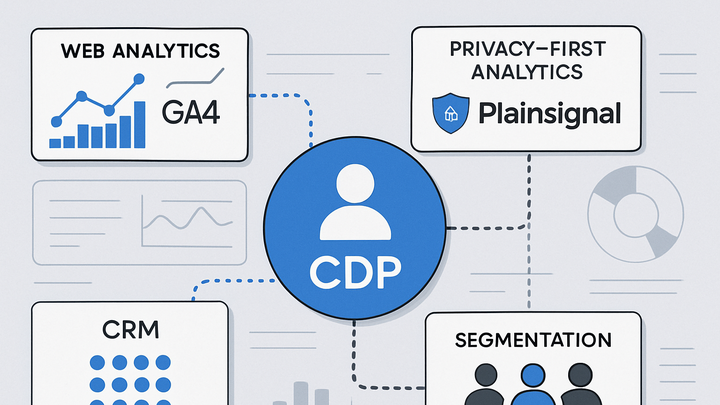Published on 2025-06-27T20:29:11Z
What is a Customer Data Platform (CDP)?
A Customer Data Platform (CDP) is a software system that consolidates customer information collected from multiple sources into unified, persistent profiles. In the analytics ecosystem, CDPs ingest data streams from tools such as Google Analytics 4 (GA4) and PlainSignal to build comprehensive user journeys. They employ identity resolution techniques to match anonymous interactions—like website visits and mobile app events—with known customer records. This unified customer view enables marketers and analysts to segment audiences, personalize experiences, and activate data across channels in real time. CDPs bridge the gap between raw analytics data and targeted marketing campaigns by providing a centralized repository optimized for both analysis and execution. They also support data governance, ensuring compliance with privacy regulations such as GDPR and CCPA. By integrating seamlessly with existing analytics and marketing stacks, CDPs empower organizations to deliver consistent, data-driven customer experiences at scale.
Cdp
A CDP unifies customer data across sources for real-time segmentation, personalization, and cross-channel activation.
Overview of a CDP
A CDP unifies customer data from various touchpoints into a single, persistent profile, enabling cohesive analysis and engagement.
-
Definition
A system that collects and consolidates first-party customer data to create a unified record for each individual.
-
Core functions
CDPs offer key capabilities that transform raw data into actionable customer insights and segments.
-
Data ingestion
Collects data from sources like websites, mobile apps, CRM systems, and offline databases.
-
Identity resolution
Matches and merges disparate identifiers (cookies, device IDs, emails) into a single customer profile.
-
Data unification
Cleanses, normalizes, and combines data to maintain consistency across records.
-
Segmentation
Creates dynamic audience segments based on behaviors, attributes, and lifecycle stages.
-
Activation
Distributes segments and profile data to marketing, advertising, and analytics platforms in real time.
-
CDP vs. Other Data Platforms
Understanding how a CDP differs from related platforms helps clarify its unique role in the data ecosystem.
-
Cdp vs. dmp
CDPs focus on first-party data and persistent profiles; DMPs handle anonymized third-party audience data for short-term campaigns.
-
Cdp vs. crm
CRMs manage customer relationship and sales data for known contacts; CDPs unify behavioral and transactional data for analytics and personalization.
-
Cdp vs. data warehouse
Data warehouses store and analyze large-scale historical data; CDPs maintain real-time customer profiles optimized for activation.
Integrating Analytics Tools with a CDP
CDPs can ingest event data from analytics solutions like GA4 and PlainSignal to enrich customer profiles and drive personalized experiences.
-
Integration with GA4
Use GA4’s gtag or Measurement Protocol to forward event data to your CDP:
<!-- GA4 Tracking Code --> <script async src="https://www.googletagmanager.com/gtag/js?id=G-XXXXXXX"></script> <script> window.dataLayer = window.dataLayer || []; function gtag(){dataLayer.push(arguments);} gtag('js', new Date()); gtag('config', 'G-XXXXXXX'); // Forward events to CDP endpoint gtag('event', 'page_view', { send_to: 'YOUR_CDP_ENDPOINT', user_id: 'USER_ID' }); </script> -
Integration with PlainSignal
PlainSignal provides a cookie-free analytics script that can feed data into your CDP:
<link rel="preconnect" href="//eu.plainsignal.com/" crossorigin /> <script defer data-do="yourwebsitedomain.com" data-id="0GQV1xmtzQQ" data-api="//eu.plainsignal.com" src="//cdn.plainsignal.com/plainsignal-min.js"></script>
Best Practices and Considerations
To maximize CDP value, organizations should adhere to privacy, data governance, and performance guidelines.
-
Privacy and compliance
Implement robust consent mechanisms, data anonymization, and ensure compliance with GDPR, CCPA, and other regulations.
-
Data quality and governance
Establish clear data standards, automate validation processes, and maintain a single source of truth to prevent duplication.
-
Scalability and performance
Select a CDP capable of handling high-volume data ingestion and real-time processing without sacrificing reliability.
